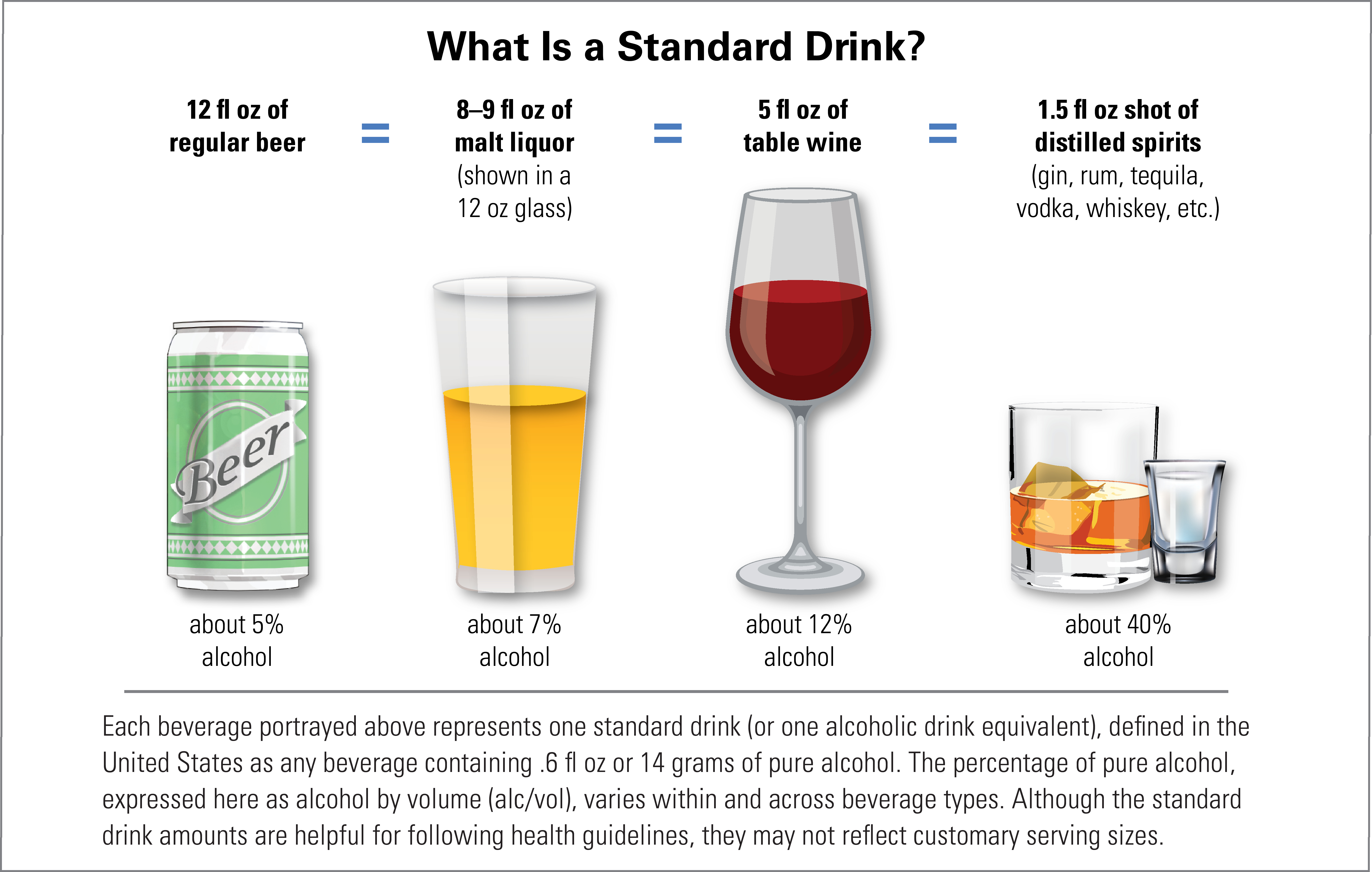Alcohol
Alcohol 101

Alcohol is a drug that is classified as a depressant, which means that it slows down your nervous system. The type of alcohol used in beverages is called ethanol. Alcohol use is often seen as a normal part of the American culture and way to socialize However, alcohol is addictive and impairs judgment, which can lead to a variety of negative consequences for drinkers and their community. In the United States, the legal drinking age is 21, but underage drinking is a big issue. Common types of alcohol include hard liquor, wine, and beer. See below for more information on drinking behaviors and alcohol measurements.
Terms:
Binge Drinking: Binge drinking is a form of high risk drinking, and refers to someone drinking a large amount in a short period of time. This type of drinking is particularly high risk, as it causes someones Blood Alcohol Content to rise rapidly, which can lead to blackouts or accidents caused by disorientation or impaired judgment. Those between the ages of 18-34 are most likely to engage in binge drinking. Students may engage in binge drinking during drinking games or if they are using it to cope with a personal situation. According to the Centers for Disease Control, binge drinking is defined as having 5 or more drinks in hours for people whose sex is male, and 4 or more drinks in 4 hours for people whose sex is female.
Pregaming: Pregaming is a drinking behavior that is common in college students. It refers to consuming alcohol (usually shots) with friends before going to a party or bar. Reasons for pregaming include saving money, or getting a buzz before showing up at an event. This behavior can be high risk as drinking before a party when you intend to drink more, can lead to overconsumption and could lead to someone getting sick or blacking out.
Low-Risk Drinking: Low-risk drinking is a form of harm reduction, which is an education approach that is an alternative to abstinence. The safest way to avoid consequences from drinking is to abstain from drinking. However, the harm reduction approach recognizes that people may still choose to drink, and seeks to reduce the harm associated, such as decreasing the risk of accidents and injury. Low-risk drinking styles include things like pacing drinks, alternating between alcohol and water, and other tips that can be found here.
Standard Drink:
A standard drink is a measure used for alcohol, standards drinks are equivalent to eachother. In other words, a shot, a glass of wine, and a glass of beer all contain around the same amount of alcohol. The standard drink measure can help people pace themselves, and determine what their intoxication level will be if they want to plan ahead. The picture below shows what a standard drink is for each type of alcohol.

Sources:
Alcohol and Public Health (CDC)
Alcohol, Tobacco, and Other Drugs (SAMHSA)
Overview of Alcohol Consumption (NIAAA)
Alcohol and the Body
Alcohol is a drug and can affect your body's functioning in the short and long term. It is also addictive, and frequent users can be physically and emotionally dependent on alcohol.
Some of the more common and short term health effects of alcohol consumption include hangovers, headaches, nausea, and a decrease in spatial skills and muscle control. Alcohol affects the brain, as alcohol is absorbed from the stomach and small intestine into the bloodstream, which means it flows through the body and reaches the brain. In terms of the brain, alcohol use, especially frequent use, affects memory, emotional regulation, spatial awareness, and judgment. Alcohol is a depressant, which means that it depresses the central nervous system and slows down breathing and heart rate. This can be particularly dangerous if someone has drank too much as it could lead to alcohol poisoning or a potentially fatal situation if someone's body starts to shut down from so much alcohol in the blood. Alcohol use can also cause blackouts, which means that someone has consumed so much alcohol that their brain stops making memories for a period of time. This typically happens with binge drinking and hard liquor consumption. With blackouts, someone can still appear to be aware and can be walking around and talking, but will have no recollection of their actions the next day. This can be scary and dangerous as it impacts a person's ability to give consent in sexual situations, and affects their general safety.
Frequent alcohol use can have many long term effects, some of which can derail someone's health, life, and career path. Alcohols is highly addictive, and those dependent on alcohol are at high risk of developing liver cancer and other health issues.
Please see here for an interactive guide on how alcohol affects the different organs in the body, as well as a BAC calculator (measure of intoxication): Alcohol and You- An Interactive Body ; Blood Alcohol Content Calculator
Sources: CDC, SAMHSA, Foundation for a Drug Free World
Alcohol Use in College
If you look at popular movies and ads featuring college life, it is clear that there is a sterotype that colleges are places for partying and drinking. At Loyola and many other institutions, that perception is very inaccurate and does not reflect our student's work ethic, passion, and drive to succeed in college and beyond. Underage drinking does occur at Loyola, but the majority of students consume in a moderate and lower risk way. A small minority of students engage in frequent and unsafe use. At Loyola, 67% of students in 2018 used alcohol in the past month (National College Health Assessment). Of the students surveyed, 18% had never used alcohol.
At Loyola Chicago, we are committed to student safety and wellness, and have resources for students who drink occasionally, drink often or in an unhealthy way, or do not drink at all.
